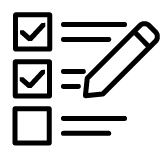Menu
Ensuring that oral health professionals are able to practise competently is one of the main ways the BC College of Oral Health Professionals (BCCOHP) protects the public. Quality assurance is an important part of this, and BCCOHP is working to establish a modernized Quality Assurance (QA) Program for all oral health professionals in BC.
With oversight from the Quality Assurance Committee, BCCOHP has developed a proposed Quality Assurance Program Framework. The proposed structure and approach for the new program is outlined below and is the focus of this consultation.
This short video provides an overview of the approach taken to developing the proposed Quality Assurance Program Framework. We encourage you to watch it before sharing your feedback.

We invite you to explore the material below and then complete the relevant survey to share your feedback on the proposed Quality Assurance Program Framework
Oral health professionals: A unique survey link has been sent to you by email—please refer to that message and use the unique link provided to you. The version for oral health professionals provides more focused questions on the overall framework as well as individual elements.
Members of the public: This consultation is now closed.
When BCCOHP was formed, the quality assurance programs from the legacy colleges remained in place. As a result, we currently have four quality assurance programs with different criteria, processes, and requirements for various members of the oral health team. Establishing a modernized quality assurance program for all oral health professionals is a goal outlined in our 2024-27 Strategic Plan.
New governing legislation for health regulatory colleges was passed in BC’s Legislative Assembly in November 2022 and is anticipated to come into force in 2025. The upcoming Health Professions and Occupations Act (HPOA) will replace the existing Health Professions Act (HPA). The principles and requirements contained in “Division 8 – Quality Assurance Program” of the upcoming HPOA have been taken into consideration by BCCOHP in the design of this proposed QA Program Framework.
The development of the proposed QA Program Framework has been informed by:
The proposed QA Program Framework seeks to provide the foundation for a program that ensures oral health professionals are able to practise competently throughout their careers.
The proposed QA Program Framework consists of three components:
 | Component A: Self-assessment |
| Component B: Education & knowledge application | |
 | Component C: Follow-up assessment |
Each proposed component is grounded in BCCOHP’s Professional Standards for the Oral Health Team and our commitment to public protection. The components are intended to enable:
Each element of the three components is informed by research and is described further in the sections that follow.
Note that the QA Program as proposed in the Framework is intended to evolve over time. As BCCOHP gathers additional insights, feedback, or data, the program can be revised to better meet needs and requirements.
The proposed QA Program Framework presents an evaluation process for the program to support ongoing improvements, alignment with regulatory changes, and continued public trust.
As they move through the proposed QA Program, all oral health professionals would complete Components A and B annually. Component C would apply only to selected oral health professionals based on specific criteria.
The visual below illustrates the high-level journey through Components A, B, and, if applicable, C.
Component A guides oral health professionals through a self-reflective process, providing opportunity to assess their practice, measure alignment with standards, and plan for continued professional development.
Oral health professionals would be able to complete all elements of Component A online.
Element | Description |
Self-inventory Estimated time to complete: 30-45 minutes annually | A guided self-inventory* is delivered through a survey form. It is confidential and designed to collect contextual data. This data would be provided to BCCOHP in aggregate (not at an individual level). It aims to identify supports that may enhance safe and competent practice. |
Recommended supports Estimated time to complete: 30 minutes annually | Oral health professionals would receive examples of relevant/recommended supports that may be used to improve professional practice and performance. These are based on responses from the self-inventory. |
Standards self-assessment* Estimated time to complete: 45-60 minutes annually | A self-assessment guides oral health professionals to reflect on their knowledge of and compliance with the principles for oral health care that are outlined in BCCOHP’s Professional Standards for the Oral Health Team. This includes a set of Likert scale questions and guided self-reflection responses. Responses and reflections from the standards self-assessment would guide an oral health professional’s continuing professional development. The data from this assessment would be recorded and may be used by BCCOHP staff and QA Assessors for follow up as needed. |
Knowledge application & self-report on continuing professional development Estimated time to complete: 15-45 minutes annually | An opportunity for oral health professionals to set SMART goals (Specific, Measurable, Achievable, Relevant, Timebound) annually and informed by feedback from the self-inventory and standards self-assessment. Oral health professionals would self-report continuing professional development activities. A recommended patient experience survey would be available to oral health professionals to gather anonymous feedback from their patients, which would support professional growth and practice improvement. For those who do not have direct patients, an additional survey would be provided to share with their collaborative oral health professionals. |
Component B focuses on measuring oral health professionals’ understanding of and compliance with BCCOHP’s standards. It provides learning and application opportunities to reinforce knowledge and support professional growth.
Element | Description |
Principles and standards: Education Estimated time to complete: 60-90 minutes per learning module (BCCOHP does not anticipate more than three learning modules per year) | A detailed review of select principles for oral health care and Practice Standards per year. The principles for oral health care are embedded in BCCOHP’s Professional Standards for the Oral Health Team, and include:
Practice Standards are additional requirements for high-risk areas of oral health care. |
Principles and standards: Knowledge application Estimated time to complete: 15-20 minutes per learning module | Scenario-based activities that allow oral health professionals to demonstrate their understanding through a series of interactive knowledge check activities. This measures and reinforces learning through practical application and scenario-based activities, reinforces key concepts and assesses comprehension/application. |
Component C has been designed to provide targeted support and follow-up for oral health professionals selected as part of a random audit or who may be identified as potentially higher risk. Tailored follow-up support ensures that oral health professionals receive additional guidance to support safe, competent, ethical, and team-based care, in alignment with BCCOHP’s professional and practice standards.
Element | Description | OHP Activity |
Step 1: Selection process | In the first step of Component C, oral health professionals are identified for follow-up based on the below:
| Complete any outstanding or incomplete QA Program elements from Components A or B. |
Step 2: | Oral health professionals who are selected for follow-up would engage with a QA Assessor to:
The goal of this component would be to support oral health professionals in aligning their practice with BCCOHP’s standards, with the help of a QA Assessor, and to develop a plan for continued professional growth. |
|
If further issues of non-compliance or risk are identified, oral health professionals would be required to engage in additional activities or processes.
Term | Description |
Self-inventory | This refers to a guided survey to collect demographic and practice-contextual data as it pertains to each oral health professional. All responses would remain anonymous and confidential. Only group (aggregate) data would be reviewed by BCCOHP. This self-inventory is to be completed by all oral health professionals. BCCOHP would only see the completion status of this assessment. |
SMART Goals | Specific, Measurable, Attainable, Realistic, Timebound professional goals that aim to develop and improve practice. |
Standards self-assessment | This refers to a guided self-assessment that is to be completed by each oral health professional as it pertains to their implementation and application of the Professional Standards. This includes a set of Likert scale questions and guided self-reflection responses. The data from this assessment would be recorded and may be used by BCCOHP staff and QA Assessors for follow up as needed. Responses and reflections from the standards self-assessment would guide an oral health professional’s continuing professional development. |
As part of BCCOHP’s commitment to modernizing its regulatory functions, the proposed QA Program Framework is designed to evolve over time. While the initial focus is to implement a core QA Program that meets upcoming requirements of new legislation, future enhancements are also planned. Planned enhancements include:
For those interested in learning more about the evidence underpinning the design of the proposed Quality Assurance Program, and diving deeper into the three components, supplementary detail is provided below.
BCCOHP has prioritized the inclusion of evidence-based methods of measuring competence into the design of the proposed Quality Assurance Program.
The following tables outline the components of the Framework as each relates to the evidence underpinning each component. The program design is informed by research commissioned to provide recommendations tailored to BCCOHP’s context.
Evidence-based method of competence measurement | How it shows up in Component A |
Guided self-assessment & self-report:
| The proposed QA Program Framework features:
|
Guided self-report:
| The proposed QA Program Framework features:
|
Multisource feedback:
| The proposed QA Program Framework features:
|
Evidence-based method of competence measurement | How it shows up in Component B |
Written Quizzes:
| The proposed QA Program Framework features:
|
Evidence-based method of competence measurement | How it shows up in Component C |
Audit:
| The proposed QA Program Framework features:
|
Multisource feedback:
| The proposed QA Program Framework features:
|
Evidence-based method of competence measurement | How it shows up in the proposed QA Program Framework |
Dashboard
| The proposed QA Program Framework features:
|
The self-inventory would be delivered through an online survey form, annually.
Upon completion of this component, oral health professionals would be able to:
Each of the six principles for oral health care embedded in BCCOHP’s Professional Standards for the Oral Health Team and Practice Standards would be assessed for delivery method (i.e., standard video, animated video, case-based learning, infographic, etc.) within an interactive component. Select Principles and Practice Standards would be selected yearly for a deep review. BCCOHP does not anticipate more than three learning modules per year.
Education on each of the six principles for oral health care embedded in BCCOHP’s Professional Standards for the Oral Health Team and Practice Standards would be complemented with a series of knowledge check activities.
This provides oral health professionals with the opportunity to apply their knowledge for learning in a safe environment. For each knowledge check activity there would be:
The list below outlines the approach for those who may be selected to participate in Component C:
Oral health professionals would only be part of Component C if they have been flagged for a follow-up with the QA Assessor as per the criteria provided above.
The list below outlines the approach for processes that would take place as part of Component C: